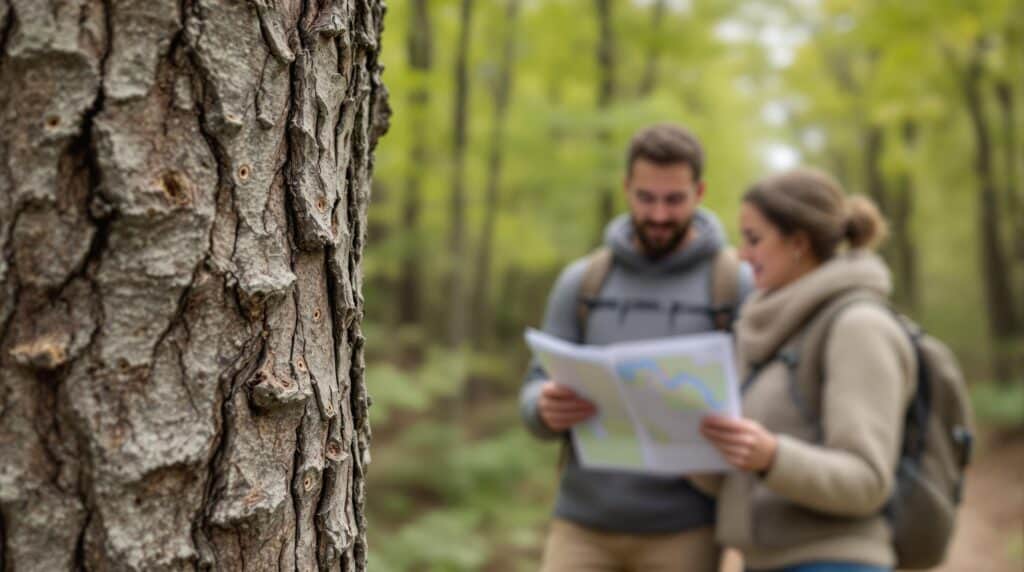Your favorite Dells shade tree might be standing strong…or it might be under silent attack from a beetle no bigger than a pinky-nail. Before you pack the picnic basket, explore our brand-new emerald ash borer (EAB) map and see exactly where the damage dots fall.
Key Takeaways
A quick glance at the bullets below arms you with everything you need to know before stepping onto the trails, pitching the tent, or launching the drone. Read them now, screenshot them for later, and you’ll navigate Bonanza like a seasoned arborist who also happens to love s’mores. With just a minute of scanning, you’ll already know more about our ash trees than most casual hikers.
• A tiny green beetle called the emerald ash borer (EAB) is hurting ash trees around Wisconsin Dells.
• A live map lets you see which picnic spots and trails still have safe shade.
• Trouble signs: D-shaped exit holes, bark chips from woodpeckers, and leaves turning brown up top.
• Trail markers: green = full shade, yellow = some thinning, red = weekday work zone.
• Campground plan: treat healthy ash, remove unsafe trees, plant many new species right away.
• Fun ways to help: kid scavenger hunts, slow “Tree Talk” walks, and drone photo tagging with #DellsTreeWatch.
• Bring no outside firewood—buy local bundles to keep the beetle from spreading.
• Volunteer planting days earn perks like free-night stays and help grow a stronger, greener forest..
Keep scrolling for the stories behind those bullets, the map link itself, and the simple actions that turn you from camper to canopy custodian in the time it takes to toast a marshmallow. After all, information isn’t power until someone—like you—uses it on the ground. Jump to the next section whenever curiosity strikes, and you’ll find richer detail waiting.
Why click in?
• Spot the safest play groves for the kids.
• Snap drone-worthy canopy shots without surprise bare patches.
• Rest easy knowing which RV pads keep their cool, leafy roof.
Read on to learn how Bonanza’s “EAB Discovery Loop” turns worry into a family scavenger hunt, shows retirees their favorite benches are still shaded, and gives weekend warriors a chance to tag #DellsTreeWatch like citizen scientists. Adventure, education, and tree-saving tips start below—let’s help the woods we all love stay green.
Meet the Beetle Behind the Ribbons
The emerald ash borer is a metallic-green insect officially named Agrilus planipennis. Don’t let its tiny size fool you; once the larvae tunnel under ash bark, they sever the tree’s water highway and the canopy browns out in as little as two years. According to the Wisconsin Department of Natural Resources’ overview, ash loss is nearly complete in counties where populations go unchecked, and Columbia County is now well within that risk zone. You can dive deeper on the DNR EAB page if you crave the scientific nitty-gritty.
Spotting trouble early turns a leisurely stroll into a mini detective mission. Look for woodpecker flecking that sprinkles bark like confetti, D-shaped exit holes about the size of a grain of rice, and sprout-filled “baby branches” popping low on the trunk. Peel back loose bark—carefully—and serpentine galleries reveal the culprits’ path. Drone pilots even report pale patches from above where bark has been stripped. The full symptom checklist, with photos, is housed in the DNR’s field guide on detection and inventory.
See the Spread: Interactive Map Highlights
Our live map pulls data straight from the Wisconsin Department of Agriculture, Trade and Consumer Protection’s detection layer. Each colored dot pins a confirmed emerald ash borer find around Wisconsin Dells, letting you zoom from a state view to your upcoming picnic table in seconds. The source map, available through DATCP’s EAB portal, refreshes whenever new reports hit the database, so you’re never operating on last year’s intel.
Inside Bonanza Camping Resort we’ve taken the extra step of tagging all 482 ash trees in our own inventory. A simple heat map shades the most urgent zones in red: Riverwalk Loop, South Creek Camp, and Oak Glen Picnic Grove. Scan the QR sign at any trailhead and your phone opens that same layer, transforming a casual hike into the “EAB Discovery Loop.” Kids can trace the colored dots like a treasure hunt while retirees see exactly which benches still nest under healthy crown cover.
Trail Status: Open, Quiet, or Under Construction
No one likes surprises involving chainsaws or detours. That’s why every path inside Bonanza now carries a color icon on the kiosk map. A green stripe means full shade and photo-ready canopy—think instant Instagram backdrop. Yellow signals partial thinning—expect flagged trunks but safe passage. Red routes close on weekdays from 7 a.m. to 3 p.m. for removal, then reopen squeaky clean by late afternoon so families can circle back for an evening walk.
Planning ahead is even easier with our public calendar. Early spring brings low-noise injections along Family Fun Trail with no closures at all. In late April we’ll remove twelve hazardous ashes beside RV Loop B; cones and detour arrows guide foot traffic while a spotter waves equipment across the service road. Volunteer weekend follows fast on the heels of that work, planting fresh bur oak, serviceberry, and hackberry—join in and earn a free night’s stay.
Bonanza’s Three-Track Action Plan
First, we protect the keepers. Ninety heritage ash trees shading playgrounds, photo spots, and classic campsites receive trunk injections that halt the beetle before it chews another millimeter. Treatments occur on a two-year rotation recommended by the DNR, timed for maximum efficacy right after adult flights begin.
Second, we remove and replant in the same breath. Any ash with more than fifty percent canopy loss comes down for safety, then a mix of bur oak, honeylocust, river birch, and Kentucky coffeetree pops up in its place. Fast-growing understory species add interim shade while the hardwoods stretch skyward. Where sun might roast an RV pad, temporary shade sails swoop in to keep laptops and iced-tea glasses cool.
Third, we educate and empower every guest. The “Buy It Where You Burn It” rule greets campers at reservation, check-in, and again on the bright yellow door-hanger inside each welcome packet. Friday nights, a twenty-minute EAB Spotter mini-class turns families into field researchers, complete with bug-detective badges and flagging tape for marking suspect trees. Photos hashtagged #DellsTreeWatch sync automatically to our shared iNaturalist project and feed state scientists the crowd-sourced data they crave.
Join the Effort: Pick Your Adventure
Eco-curious families, grab the scavenger-hunt card at the camp store. When the kids locate a woodpecker chip, a D-hole, and one pristine ash leaf, trade the completed card for a double-scoop ice-cream voucher. Parents often report the list keeps little feet marching far longer than simple cajoling ever could.
Nature-loving retirees, Wednesday’s “Quiet Walk & Tree Talk” meanders one mile per hour, plenty slow for birdsong and conversation. Large-print maps highlight benches, restroom stops, and future planting zones, giving you a peaceful yet informed tour. Let the grandkids know you’re busy doing citizen science while still getting those coveted afternoon naps.
Adventure-seeking millennials and couples, the overlay for top-tier canopy drone shots is a one-click download. Tag your best frame with #DellsTreeWatch and see it featured on our feed. Bonus points if your post includes coordinates of a suspect tree logged through iNaturalist.
RV travelers and digital nomads, the latest KML layer weighs in at just 500 KB, light enough for campground Wi-Fi. Certified kiln-dried bundles sit stacked outside the office for five bucks; outside firewood risks a statewide $100 fine, so skip the haul and help the trees. Keep those laptops cool under a well-managed canopy and your Zoom background will feature real-life leaves instead of virtual ones.
Safety While You Sleep
Tree crews roll in Tuesday through Thursday at dawn, when most campers still dream under the covers. Bright barrier tape snaps up around equipment zones, and multilingual signs politely remind early risers to take an alternate path. A designated spotter stands where footpaths intersect work areas, ushering joggers and strollers through with a smile and a wave.
By mid-afternoon, chainsaws power down and a debris sweep follows: limbs loaded, hardware checked, and sawdust blown clear. Even the tiniest splinter is hunted before s’mores time, so you can relax knowing your favorite bench and picnic area remain welcoming, clean, and quiet. Evening air smells like pine needles, not gasoline, and the only thing dropping from above is starlight.
A Greener Canopy on the Horizon
Diversity is our north star. By 2028 we plan to reduce ash to twenty percent or less of total tree count while adding ten new species, each chosen for wildlife value and climate resilience. Monarchs gain nectar on spring serviceberry blooms, songbirds feast on autumn hackberry drupes, and human visitors enjoy a richer palette of leaf colors come October.
Annual progress reports land every March on the Bonanza blog and in Tree-Watch email alerts. Subscribe once, and you’ll receive fresh drone overlays, volunteer sign-up dates, and honest scorecards on canopy recovery. Transparency keeps us all accountable and gives returning guests the joy of spotting “their” seedling stretching taller each season.
Each pin you see on the EAB map is more than data—it’s a promise that the shade you love is being protected. Come trace those dots in person, earn your bug-detective badge, and fall asleep beneath a canopy we’re all keeping green together. Reserve your favorite RV pad or cozy cabin at Bonanza Camping Resort today, and turn your next Dells getaway into a memory-making mission for healthier north-woods forests. Your adventure—and our brighter, leafier tomorrow—starts the moment you click “Book Now.”
Frequently Asked Questions
Q: Are the playground and picnic trees still safe for my kids to play under?
A: Yes—every ash tree near high-traffic areas is inspected monthly, and the healthiest ones receive protective trunk injections while weakened trees are promptly removed and replaced, so your family’s favorite climbing, photo, and nap spots remain sturdy and shaded.
Q: Will we notice big bare patches or closed trails on our vacation dates?
A: Most routes stay open year-round; only weekday daylight hours see short closures, clearly marked on kiosk maps and the online calendar, and by late afternoon fresh mulch covers the work zones so evening strolls look—and feel—normal.
Q: Can we still enjoy a classic campfire, and what’s the rule on bringing wood from home?
A: Campfires are welcome as long as you burn the certified kiln-dried bundles sold at the resort store; outside firewood is prohibited to stop hitchhiking beetles and avoid a hefty state fine, so skip the haul and keep the Dells’ trees healthy.
Q: How do I pull up the emerald ash borer map on my phone once I arrive?
A: Just scan any green QR code posted at trailheads, the camp store, or the welcome center and the live map opens instantly, letting you zoom from a bird’s-eye view of the Dells down to the exact site of your RV pad or picnic table.
Q: We’re tech-savvy RVers—can we download the latest KML layer before losing Wi-Fi on the road?
A: Absolutely; the 500-kilobyte KML file sits under the “Map Tools” button on our blog and caches offline, so you can overlay it on your favorite navigation app and keep satellite dishes, awnings, and laptops out of limb-fall zones.
Q: I’m a retiree who loves quiet shade walks—are my usual benches still under canopy?
A: Rest easy; the benches along Riverwalk Loop and Oak Glen remain shaded thanks to proactive treatments, and our Wednesday “Quiet Walk & Tree Talk” highlights any new plantings so you can track the canopy’s comeback year after year.
Q: Which locations still offer full green cover for drone and Instagram shots?
A: Look for the solid-green icons on our interactive map—especially North Bluff Overlook and Cedar Ridge Spur—because those spots have had zero canopy loss, giving you uninterrupted emerald backdrops perfect for aerial panoramas.
Q: What should we do if the kids or our drone spot a tree that looks sick?
A: Snap a photo, drop a pin in the iNaturalist app, and tag it #DellsTreeWatch; our arborist team gets an automatic alert, investigates within 48 hours, and your family earns an “EAB Spotter” badge redeemable for free ice cream.
Q: Are there volunteer events where we can help—and maybe earn a free stay?
A: Yes, our spring and fall planting weekends pair fun, light work with perks like free night vouchers, s’more socials, and swag, so sign up on the blog calendar, bring gardening gloves, and leave with both memories and rewards.
Q: How often does Bonanza update its emerald ash borer strategy?
A: We review data each winter, publish a transparent progress report every March, and adjust treatments, removals, and replanting goals accordingly, ensuring the action plan stays ahead of the beetle and in line with guest feedback.
Q: Will chainsaw work or falling branches disturb our midday naps or Zoom calls?
A: Tree crews run only Tuesday through Thursday mornings, shut down by early afternoon, and a spotter keeps pathways safe, so after lunch you’ll enjoy the usual birdsong soundtrack whether you’re lounging in a hammock or on a video call.
Q: How long until the forest looks fully recovered from EAB damage?
A: Thanks to protective treatments and diverse replanting, guests already see fresh green growth, and with continued care we expect a richer, multi-species canopy in five to eight years, meaning each return trip should reveal thicker shade and brighter fall colors.



